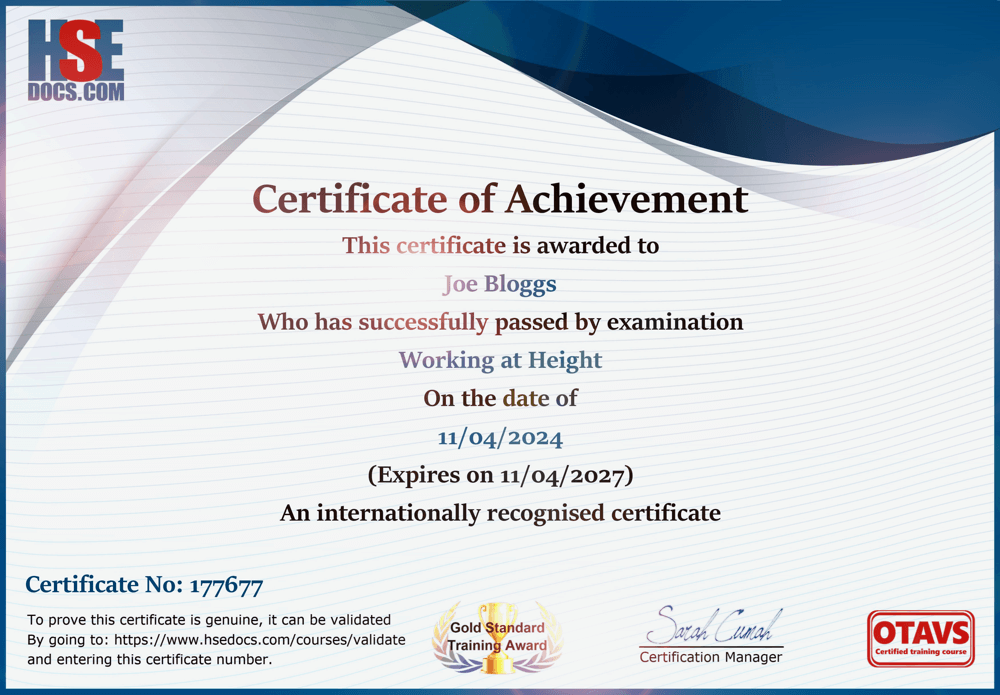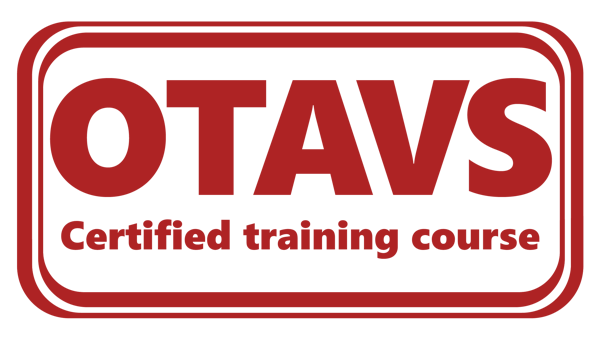Online Level 2 Food Safety Course from £4.99
AKA Food Hygiene

Course certificate valid for 3 years
Internationally accredited training
Take an HSEDocs Level 2 Food Safety course and obtain an internationally recognised certificate. This thorough course covers all the essential topics related to food hygiene to ensure that you acquire the necessary knowledge and skills to handle food safely and hygienically. Upon finishing the course, you will receive a certificate that remains valid for three years and is recognised internationally by employers and Environmental Health Officers (EHOs).
With our course prices, you get the best value for your money. Individual courses cost £9.99 each, but you can get them for only £6.49 each if you order ten or more. Bulk orders of 50 or over cost just £4.99 per course.
Course duration: Between 1 ½ and 2 ½ hrs depending on learning speed.
Course format: Three video training modules, with a multiple-choice section at the end of each module.
Entry Requirements: Anyone can complete this course, whether they have previous experience or not.
If you work in a cafe, chip shop, restaurant, fast food outlet, mobile catering unit, hotel kitchen, hospital kitchen, school kitchen, college kitchen, or outdoor cooking events, then this online Level 2 Food Safety certified course is for you.
All successful candidates are entered on the national training register, and certificates can be verified by employers or others to prove that they are genuine by clicking Validate a Certificate and typing in the certificate number.
Overview of HSE Docs Level 2 Food Safety Course
Our Level 2 Online Food Safety course follows the current national curriculum. The learning topics covered in this HSE course include:
- Personal and kitchen hygiene.
- Risk assessment and control measures.
- Temperature control and its importance.
- Cross-contamination risks.
- Food hazards and how to avoid them.
Personal and kitchen hygiene emphasizes the importance of cleanliness and the potential consequences of not meeting the necessary standards to keep food safe from hygiene hazards.
The section on risk assessments explains how and why to evaluate risks within a catering environment and how to implement control measures to reduce or eliminate potential risks.
The importance and relevance of temperature control when storing or cooking, highlights that temperature control is a precise science that must be strictly observed to avoid potential risks that could occur if ignored.
The risk of poisoning due to cross-contamination between different food items is highly likely without adequate training, and this section addresses all aspects of potential cross-contamination.
The final section covers the use of HACCP (Hazard Analysis Critical Control Point) to identify, monitor, and mitigate potential risks.
Our Level 2 online Food Safety certificate is internationally recognised and counts towards your Hygiene Rating, which you can find out more about in our latest blog - ‘Your Guide To Food Hygiene Ratings.’
- Instant access and ongoing support throughout your HSE course
- Conforms to UK and EU legal requirements.
- 24/7 online access to level 2 Food Safety course materials.
- Food Safety course content is accessible on all devices, including mobiles and tablets.
- 85% first-time pass rate.
- Unlimited access to the training material and free resits if you fail any of the Level 2 Food Safety modules.
- Certificate of Training available as an instant download upon successful completion of the Online Level 2 Food Safety course

The Food Standards Agency (FSA) states:
‘By law, food business operators must ensure that food handlers receive the appropriate supervision and training in food hygiene, which is in-line with the area they work in and will enable them to handle food in the safest way.’
The UK Government states:
‘All personnel involved within the food supply, production and service chain, regardless of their rank, must undertake food hygiene training in order to meet the legal requirement.’
It is essential to note that training is a legal requirement, and obtaining a Level 2 Food Safety certificate demonstrates that you have comprehensive and up-to-date knowledge. Our food hygiene training covers all the crucial practices and disciplines necessary for maintaining food safety and is easily accessible across all platforms. Additionally, you have the flexibility to take the course at your own pace, making it convenient to fit into your busy schedule.
The Level 2 Food Safety online course delivers vital knowledge and skills to learners in a clear and concise manner. The course content is designed to be easily comprehensible for all candidates and encompasses a wide range of topics related to food hygiene. Through this course, learners will grasp various principles and objectives crucial for maintaining food safety standards. They will also learn about the significance of upholding hygiene practices to ensure the safety of food products and prevent foodborne illnesses. Candidates will gain an understanding of the importance of the following:
- Understand best food handling practices, identify hygiene hazards, and implement control measures.
- Understanding safe storage temperatures, cooking temperatures, and which temperatures and conditions fall in the danger zone.
- Understanding the importance of personal and workstation hygiene.
- Understanding the industry regulations about preparing, cooking, and handling food safety.
- Understanding the legal obligations of food handlers.
- Understanding food contamination and food poisoning.
- Understanding waste management, pest control and safe working environments.
- Understanding how and why the correct cleaning process should be carried out.
The Food Safety (General Food Hygiene) Regulations 1995 states that:
- An adequate number of washbasins must be available, suitably located, and designated for hand washing. An adequate number of flush lavatories must be available and connected to an effective drainage system. Lavatories must not lead directly into rooms in which food is handled.
- Washbasins for hand washing must be provided with hot and cold (or appropriately mixed) running water, materials for hand washing, and hygienic drying. Where necessary, the provisions for washing food must be separate from the hand-washing facility.
- Adequate changing facilities for personnel must be provided where necessary.
These regulations are in place to ensure that staff welfare facilities are suitable for the basic hygiene steps they must follow.
These include clothing that should be suitable, clean, and protective and hair that should be tied back if necessary and suitably covered. Additionally, attention must be given to refraining from touching the face and hair, smoking, spitting, sneezing, eating, or chewing gum.
It is imperative to carry out effective handwashing to prevent the spread of harmful bacteria from people's hands. All staff working with food must wash their hands:
- When in the kitchen or preparation area
- Before preparing food
- After touching raw food
- After handling food waste or emptying a bin
- After cleaning
- After blowing their nose
- After breaks
- After touching phones, light switches, door handles, and cash registers
More on handwashing can be found on the FSA site.
Staff must also be fit for work and are not allowed to handle food or enter a food-handling area if they:
- are suffering from or carrying a disease likely to be transmitted through food
- are suffering from or carrying a disease likely to be transmitted through food
- have diarrhoea
More on fitness for work can be found on the FSA site.
Take our Food Safety Level 2 course to learn that kitchen risk assessments are a legal process that identifies potential hazards and introduces control measures to prevent or significantly reduce the likelihood of harm being caused to people to an acceptable level.
The Management of Health and Safety at Work Regulations 1999 state that:
3.—(1) Every employer shall make a suitable and sufficient assessment of—
- (a)the risks to the health and safety of his employees to which they are exposed whilst they are at work; and
- (b)the risks to the health and safety of persons not in his employment arising out of or in connection with the conduct by him of his undertaking,
Yet the law doesn't expect you to eliminate all risk, but you must protect people as far as is 'reasonably practicable'. You can find more information on risk assessment at the HSE's 'Health and Safety Basics for Your Business' website.
Kitchen Risk Assessments stem from the Health and Safety at Work Act etc 1974, which is the primary piece of legislation covering occupational health and safety in Great Britain. The risks assessed cover the safety of employees, staff, delivery drivers and anyone else who may enter the premises or be affected by the work.
However, in a kitchen environment, Risk Assessments are primarily designed to protect people from harm from the environment or equipment used. Alongside risk assessments , there should be a HACCP System implemented to keep food safe from biological, chemical, and physical hazards.
The regulations in England regarding food safety and hygiene, specifically Regulation 32 and Schedule 4, establish temperature control requirements for most food premises. These regulations have been written to comply with Regulation (EC) No 852/2004.
Temperature control is of paramount importance to food safety management systems, and food business operators must implement this in line with HACCP principles.
Temperature controls are in place for cooking, hot holding, reheating, refrigerating, cooling, freezing, and defrosting
Food Standards Scotland states:
- Refrigeration:
A food temperature of 8°C or below is effective in controlling the multiplication of most bacteria in perishable food. It is recommended practice to operate refrigerators and chills at 5°C or below. -
Freezing:
Freezing of food at temperatures of -18°C or below will prevent bacteria multiplying. -
Cooking:
Temperatures of 75°C or above are effective in destroying almost all types of bacteria. However, cooking temperatures below this level are also effective provided that the food is held at these temperatures for a suitable time period. (refer to the Cooking HACCP chart). -
Hot holding:
Temperatures above 63°C will control the multiplication of bacteria in hot food. -
Cooling:
Food should be cooled as quickly as possible and then refrigerated. This will limit the growth of any bacteria or germination of spores that may be present. -
Reheating:
All food that has previously been heated and is to be re-heated, must be raised to a temperature of 82°C, which will ensure that food has been reheated to a safe and, in some cases, legally required temperature. Using a suitable time/temperature combination will also ensure that food has been reheated safely should higher temperatures be detrimental to the quality of the food, for example reaching a core temperature of 70°C for 2 minutes.
The FSA states that:
Cross-contamination is thought to be the cause of most foodborne infections.
Cross-contamination occurs when bacteria or other microorganisms are unintentionally transferred from one object to another. The most common example is the transfer of bacteria between raw and cooked food, which is thought to be the cause of most foodborne infections. When you're preparing raw chicken, bacteria can spread to your chopping board, knife, and hands, potentially causing food poisoning if proper precautions aren't taken. Cross-contamination can also occur in less obvious ways, such as through reusable shopping bags, or from drips and splashes produced when washing meat, which can contaminate other surfaces.
Food Standards Scotland offers the following tips to avoid cross-contamination:
- don't wash meat before cooking it. It won’t get rid of the harmful bugs and you could splash these bugs onto other areas of the kitchen or onto yourself
- wash hands in warm, soapy water after touching raw food (such as meats and fish) and before handling ready-to-eat foods (such as salad vegetables)
- keep raw meat/poultry and ready-to-eat foods separate during storage and preparation
- don’t use the same chopping board or utensils for raw meat/poultry and ready-to-eat food (such as salads) without washing the board and utensils thoroughly in between uses
Our Level 2 food safety course teaches the reasons for avoiding cross-contamination and provides guidance on what to do and what not to do when preparing, cooking, and storing foods. You will learn how to prevent cases of food poisoning caused by bacteria from raw food coming into contact with ready-to-eat food. Cross-contamination can happen at any stage in the food supply chain, and we will teach you the best ways to avoid it.
To determine the level of food hygiene training you need, consider your job role and daily tasks. According to EC Regulation 852 , your training should correspond to your job responsibilities. We have created a useful guide that will help you understand the appropriate level of food hygiene training required for restaurant settings.
| Food Hygiene Level Guide | |
|---|---|
| Front of House & Wait Staff | Level 1 |
| Porter & Assistants | Level 1 |
| Line Cooks | Level 2 |
| Kitchen Managers & Supervisors | Level 3 |
| Restaurant Owners or Ops Managers | Level 4 |
Booking a food safety course with us is just like shopping on most online retailers. You can choose the course you want and add it to your cart. Then, simply proceed to checkout. If you already have an account with us, you will be asked to log in before confirming your purchase. However, if this is your first time using our platform, you will need to provide your personal information, which will register you for an account once the purchase is complete.
Your account will enable you to track individual candidates' course progress, store their certificates, and view your purchase history.
The admin panel offers several viewing options. You can view ALL COURSES, AVAILABLE COURSES, IN PROGRESS courses, and EXPIRED COURSES.
The Level 2 Food Safety certificate is essential for any food outlet, as it demonstrates that your staff has received the latest and most comprehensive training. This certificate is not only legally required, but it also highlights your organisation's commitment to the safety of both your staff and customers. Additionally, obtaining this certificate contributes to your organisation's Food Standards Agency (FSA) rating, which can significantly impact your business's reputation and success.
Understanding the significance of maintaining food safety standards is crucial for anyone who handles or prepares food. While complying with legislation is one reason for undertaking food safety training, it is equally essential for all staff to be well-informed about the food safety course content and to have a clear understanding of their duties and responsibilities. This ensures they can handle foodstuff safely and hygienically, reducing the risk of contamination and promoting consumers' overall health and well-being..
By the end of this HSE Docs Food Safety course, you will gain the practical skills and knowledge to:
- Best practices to use and implement when handling food.
- Identifying hygiene hazards and implementing relevant control measures, including HACCP. Find out more about the importance of HACCP in one of our recent food safety blogs.
- Understanding the reason for safe temperature controls for storage and cooking.
- Knowing how to avoid foods being in the temperature danger zone and why it should be avoided.
- Understanding the importance of personal and workstation hygiene and hygiene controls.
- Knowing the industry regulations about preparing, cooking and handling food safely.
- Understanding how and what food poisoning and contaminants are and the effect these can have on consumers.
- Understanding the importance of hygiene with respect to waste management, pest control and safe working environments.
- Understanding their moral and legal responsibilities to the employer and consumer, including when to undertake risk assessments.

Contact Our Food Health & Safety Experts
We are always happy to help here at HSE Docs, so if you have any questions or concerns about the online Food Safety course or any other HSE Docs online training queries, please give us a quick call.

 CART
CART 














